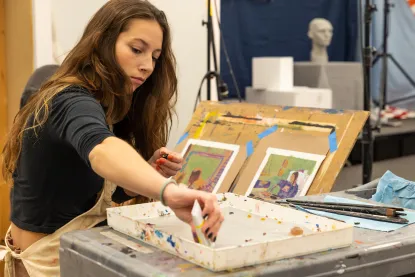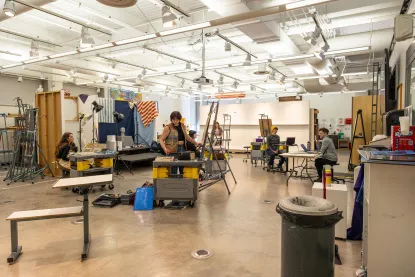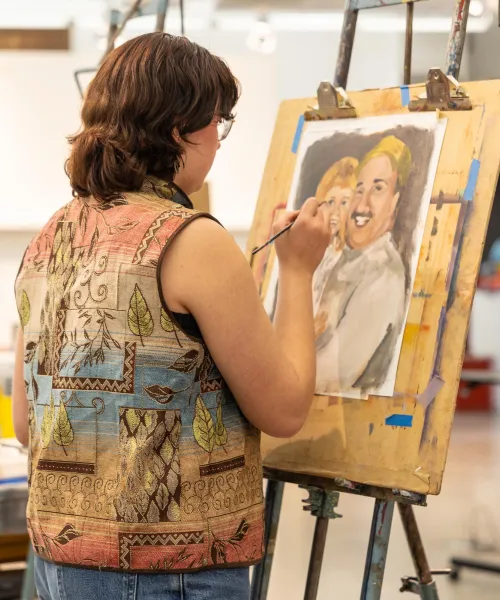Quick Links

About the Program
The Drawing/Painting program at NMU provides students with a strong foundation in techniques such as acrylic, oil, collage, and mixed media. Courses explore color and compositional relationships through both abstract and representational approaches. Ideation, problem-solving, and conceptual practices are introduced at the 100 level and further developed in upper-level courses, where students learn to invest in their creative practice and connect research to meaning.
A junior-level portfolio review emphasizes stylistic and conceptual consistency, preparing students for capstone and 400-level courses focused on professional practices. These experiences culminate in a student exhibition at the DeVos Art Museum. Throughout the program, students work closely with advisors and faculty mentors, ensuring a customized, student-centered approach that supports a sustainable creative practice beyond Northern.
Drawing/Painting Faculty
Drawing/Painting Courses
ARTD 220 Drawing/Painting Foundations: Acrylic
4 credit hours
Offered: Winter
An introductory drawing/painting course focusing on properties of, and techniques for, controlling acrylic paint, both abstractly and representationally. Foundational principles in composition, color, and observation are introduced.
ARTD 221 Drawing/Painting Foundations: Oil
4 credit hours
Offered: Fall
Introduction to foundational properties and techniques of oil paint as a medium. Emphasis is placed on representational techniques and subject matter. Approaches to developing personal style and content are introduced.
AD 320: Drawing/Painting: History and Influence
4 credit hours
Offered: Fall, odd-numbered years
Prerequisite: At least two of the following: AD/ARTD 219, AD/ARTD 220, ARTD 221, AD 319A, AD 319B; or instructor permission.
Students will produce several bodies of work that demonstrate understanding of the stylistic, historical, and conceptual context of their studio practice within the history of painting and drawing. Students may produce work in any combination of drawing and painting media.
Emphasis is given to developing a personal style through self-directed research.
AD 420 Drawing/Painting: Seminar
4 credit hours
Offered: Winter, even-numbered years
Prerequisite: At least three from: AD/ARTD 219, AD/ARTD 220, ARTD 221, AD319A, AD 319B, AD 320, AD 419; or instructor permission.
Students will plan, research, and execute self-driven projects. The content of these projects will follow consistent and coherent themes determined by the student. Content will be supported by readings, discussions, writing, critiques, and guided exposure to professional opportunities in the field.
AD 431 Portfolio: Illustration & Painting
4 credit hours
Offered: Winter, odd-numbered years
Prerequisite: AD 303, and at least two from AD319A, AD319B, AD320, AD419, O 1D420; or instructor's permission
Through individualized projects, students will refine their technical skills, artistic vision, and professional presentation to create portfolios and promotional materials that reflect their career goals and unique strengths.

Drawing/Painting Studio
The Drawing/Painting studio features a large, multi-purpose space suitable for both introductory and upper-level courses. Advanced students have individual supply carts and access to vertically separated storage for large works. The studio is equipped with a ceiling-mounted artificial lighting grid and shares excellent ventilation with the adjacent Printmaking Studio, which includes a dedicated airbrush area with a large overhead hood vent. A separate work area houses a table saw, miter saw, and worktables for frame construction and canvas preparation.
Drawing/Painting FAQ
What is the difference between a Bachelor of Fine Arts (BFA) in Drawing/Painting and a Bachelor of Arts (BA) or Bachelor of Science (BS)?
The BFA in Drawing/Painting is a professional studio degree with more credits in the program and additional studio requirements, such as Sculpture, Drawing, Metal, and Woodworking. It also includes more art history courses and does not allow a minor.
The BA and BS degrees are more flexible, allowing students to combine their major with a minor, such as Music or another area of interest. The BA also includes a world language requirement.
Does the school require a portfolio review before you are accepted into our programs?
If you are accepted to the university, you may pursue a degree within the School of Art & Design. While a portfolio is not required for entry, you may choose to present one to a professor in your studio area. Faculty can use this portfolio to determine whether you qualify for advanced placement credit (replaces both the course and credit hours), a waiver (replaces the course but not the credit hours), or to identify the appropriate studio level for you to begin. Portfolios may be reviewed during a campus visit or during a faculty member’s office hours during the semester.
Although there is no required portfolio review to enter the program, all Art & Design majors are required to complete a portfolio review with faculty (Individual Art Review, AD 303) during the twelfth week of each semester.
For information on general University admission requirements, contact the Admissions Office.
What will we need for supplies or equipment?
Students at the introductory level pay a share, which provides many items used by the students, such as canvas and gesso. After the 200 level class, all students are responsible for purchasing their own supplies. The university provides equipment items such as a chop saw, airbrushes, hand tools, etc.
What are the prospects for employment with a degree in Drawing/Painting?
Many students go on to graduate studies and seek assistantships to defray costs. Others usually seek day jobs in art related situations (sign-shop) and pursue their own work in their free time or seek gallery representation. Their long-term goal is to sell their work in a gallery and live off sales of paintings. Many also pursue jobs as illustrators, teachers, portrait and mural painters.
Are there scholarships available for incoming first-year students?
For information about scholarships for incoming freshmen, please visit the Scholarships & Financial Aid page.
